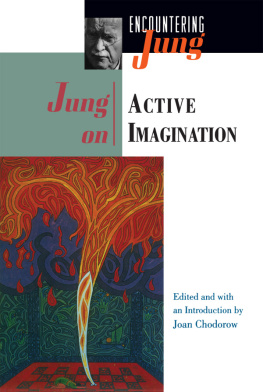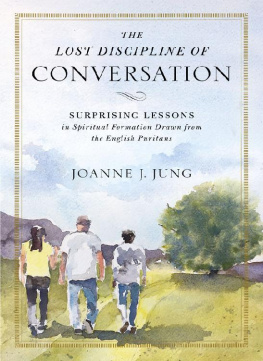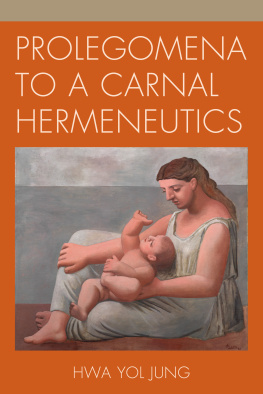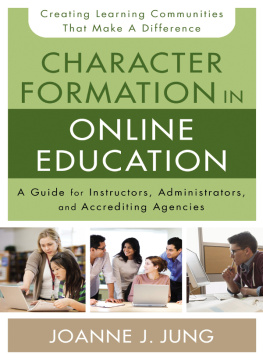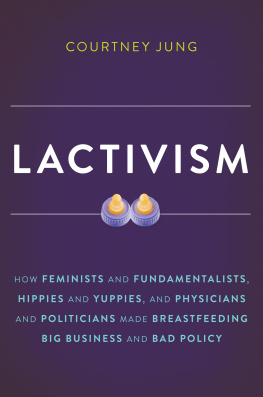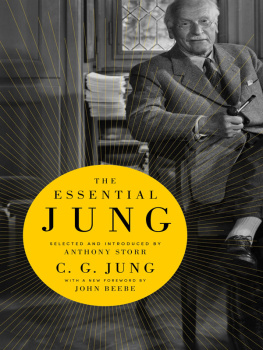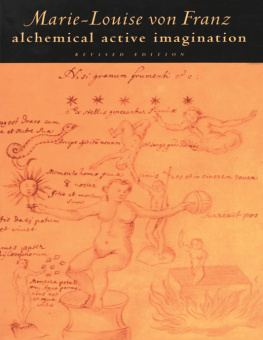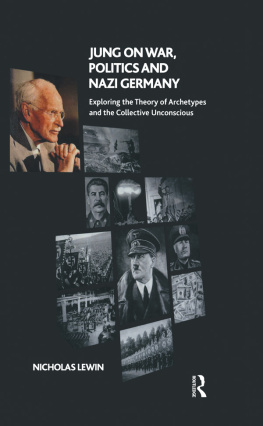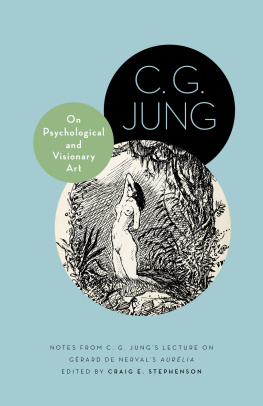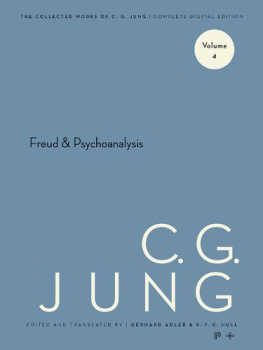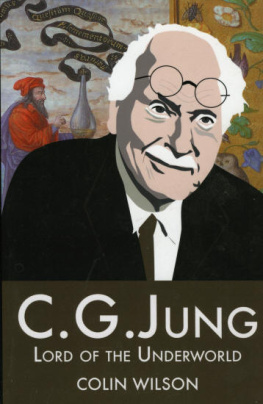
ENCOUNTERING
JUNG
JUNG ON ALCHEMY
JUNG ON EVIL
JUNG ON ACTIVE IMAGINATION
JUNG
ON ACTIVE IMAGINATION
ENCOUNTERING
JUNG
ON ACTIVE IMAGINATION
EDITED AND WITH AN INTRODUCTION BY JOAN CHODOROW
PRINCETON UNIVERSITY PRESS PRINCETON, NEW JERSEY
Published by Princeton University Press, 41 William Street,
Princeton, New Jersey 08540
In the United Kingdom by Routledge, 11 New Fetter Lane, London EC4P 4EE
All Rights Reserved
1997 Introduction, afterword and selection by Joan Chodorow. Material extracted from Memories, Dreams, Reflections, 1977 Random House, Inc. The Transcendent Function and a portion of On the Nature of the Psyche extracted from Volume 8 of the Collected Works, 1960 Bollingen Foundation. A section from The Relations Between the Ego and the Unconscious in Two Essays on Analytical Psychology extracted from Volume 7 of the Collected Works, 1966 Bollingen Foundation. A portion of Commentary on Secret of the Golden Flower extracted from Volume 13 of the Collected Works, 1967 Bollingen Foundation. The Aims of Psychotherapy extracted from Volume 16 of the Collected Works, 1966 Bollingen Foundation. Portions of A Study in the Process of Individuation and The Psychological Aspects of the Kore extracted from Volume 9.1 of the Collected Works, 1959 Bollingen Foundation. Portions of The Tavistock Lectures and Foreword to Van Helsdingen: Pictures from the Unconscious extracted from Volume 18 of the Collected Works, 1977 by the heirs of C. G. Jung. Material extracted from Volume 1 of C. G. Jung: Letters, 1973 Princeton University Press. Material extracted from Mysterium Coniunctionis in Volume 14 of the Collected Works, 1963 Bollingen Foundation.
Typeset in Times by PontingGreen Publishing Services, Chesham, Buckinghamshire
Library of Congress Cataloging-in-Publication Data
Jung, C. G. (Carl Gustav), 18751961.
[Essays. English. Selections]
Jung on active imagination / edited and with an introduction by Joan Chodorow.
p. cm. (Encountering Jung)
Includes bibliographical references and index.
ISBN 0-691-01576-7 (pbk.: alk. paper)
1. Imagination. 2. Subconsciousness. 3. Psychoanalysis. 4. Jungian psychology.
5. Jung, C. G. (Carl Gustav), 18751961.
I. Chodorow, Joan, 1937 . II. Title. III. Series: Jung, C. G. (Carl Gustav), 1875-1961.
Selections. English. 1995.
BF173.J6623 1997
153.3dc21 97-9422
Princeton University Press books are printed on acid-free paper and meet the guidelines for permanence and durability of the Committee on Production Guidelines for Book Longevity of the Council on Library Resources
Printed in the United States of America
10 9 8 7 6 5 4 3 2 1
My most fundamental views and ideas derive from these experiences. First I made the observations and only then did I hammer out my views. And so it is with the hand that guides the crayon or brush, the foot that executes the dance-step, with the eye and the ear, with the word and the thought: a dark impulse is the ultimate arbiter of the pattern, an unconscious a priori precipitates itself into plastic form.
(C. G. Jung 1947, par. 402)
Illustrations
FROM The Archetypes and the Collective Unconscious |
FROM The Tavistock Lectures |
List of abbreviations used in notes
Numbered notes at the end of the chapters are mainly previously published notes by Jung. Additional notes are from Aniela Jaff [A.J.], Cary F. Baynes [C.F.B.], Joan Chodorow [J.C.], the editors of the Collected Works [EDITORS] and Letters. Works by Jung cited in the endnotes are identified by the following abbreviations.
MDR | Memories, Dreams, Reflections by C. G. Jung. Recorded and edited by Aniela Jaff; translated by Richard and Clara Winston. See Jung 1961 in Bibliography. |
CW | The Collected Works of C. G. Jung. Edited by Gerhard Adler, Michael Fordham, and Herbert Read; William McGuire, Executive Editor; translated primarily by R. F. C. Hull. New York and Princeton (Bollingen Series XX) and London (Routledge), 195383. 21 volumes. |
Letters | C. G. Jung: Letters. Selected and edited by Gerhard Adler in collaboration with Aniela Jaff; translations by R. F. C. Hull. Princeton (Bollingen Series XCV) and London (Routledge), 1973, 1975. 2 volumes. |
Works by other authors cited in the endnotes are identified by title, author, or both. For more information on Jungs sources, see bibliographies at the end of CW volumes 7, 8, 9.I, 13, 14, 16, 18. Further abbreviations used in the notes include:
Cf. | confer, or compare |
DV | Deo volente. God willing |
f. | and the following page |
ff. | and the following pages |
fig. | figure |
Ibid. | ibidem, in the same place (refers to a single work cited in the note immediately preceding) |
n.d. | no date |
ms. | manuscript |
s.v. | sub verbo, under the word |
viz. | videlicet, namely |
Acknowledgements
When I first met Ruth Thacker Fry, she invited me into her office to see a notebook that contained everything she could find of Jungs writings on active imagination. This was many years ago, long before the time of desk computers, scanners or copy machines. Jungs papers had been typed on an old-fashioned typewriter, including scholarly footnotes and annotations. In a playful way she told me that it was not her idea, but her animus led her to do it. We both laughed, because I too know what it is to be seized by the spirit. As we looked through her notebook together, I asked if she planned to submit it for publication and she said no, there wasnt enough interest yet but someday, a volume of Jungs papers on active imagination would be published. That unique collection was for her own use. Her passion for active imagination impressed me deeply. Dr. Fry, Founding Director of the C. G. Jung Educational Center of Houston passed away some years ago, but I trust she would be pleased that the time has come for Jung on Active Imagination. The early collection she compiled and edited is a source of inspiration for this work.
I am happy to say that Jung on Active Imagination will now be simultaneously published on both sides of the Atlantic. David Stonestreet initiated the project from London when he invited me to submit a proposal. For many years now I have been impressed with his vision of Jung and the depth of understanding he brings to his work. I am grateful also to Edwina Welham for her patience and skill in moving it all toward publication; to Patricia Stankiewicz for her fine desk editing; I owe a debt of gratitude to Jo Thurm and Judith Reading, all at Routledge in England. My appreciation to Deborah Tegarden at Princeton University Press in the United States, and to many others who work their magic as they transform a manuscript into a book.
My heartfelt thanks to Andrew Samuels for his interest, encouragement, and good ideas at many stages along the way. As advisor in Analytical Psychology to Routledge, and as colleague and friend, his contribution has been invaluable.
Renate Oppikofers beautiful translation of a passage by Tina Keller has restored a long-lost piece of history about dance as a form of active imagination. Who would have believed that Toni Wolff was not only an early Jungian analyst, but also perhaps the first dance therapist? (See my Introduction on p. 16.)
Next page
